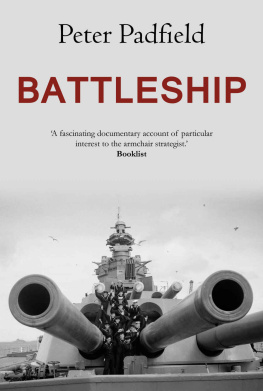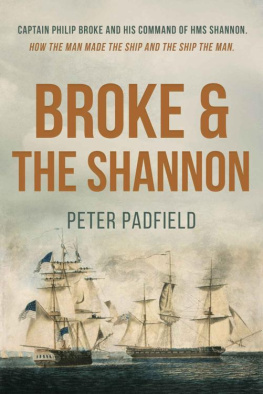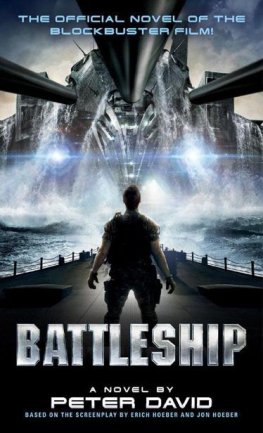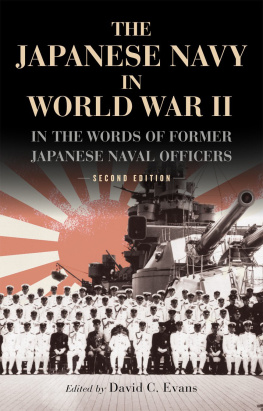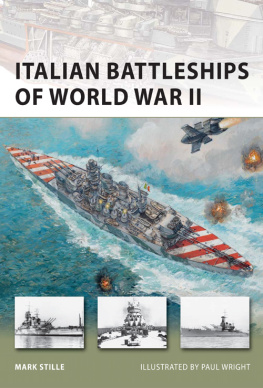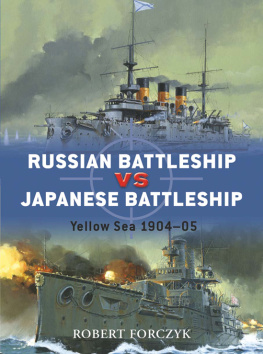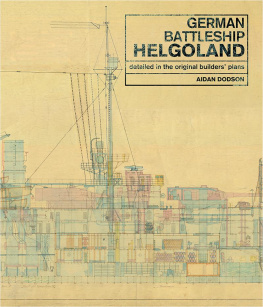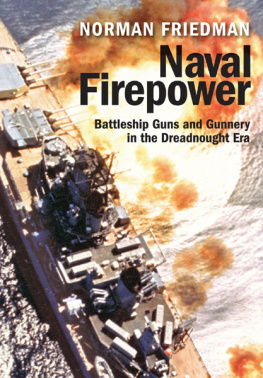Battleship
Peter Padfield
All Rights Reserved
Copyright Peter Padfield 1972, 2015
First published in 1972 as The Battleship Era by Rupert Hart-Davis Ltd, London
This edition published in 2015 by:
Thistle Publishing
36 Great Smith Street
London
SW1P 3BU
www.thistlepublishing.co.uk
Contents
List of Illustrations
Plates
Between pages 34 and 35
Between pages 98 and 99
Between pages 162 and 163
Between pages 226 and 227
Illustrations in the text
.
Acknowledgements
Much of my research was at the Naval Library, London, and I should like to thank Rear Admiral P. N. Buckley, CB, DSO, and the staff of the Library for their help and knowledge; I should like to express my gratitude as always to the Library Interlending Service, and the Staff of Sudbury County Library. I am also grateful to Mr Martin Holbrook for his splendid line diagrams. I should also like to thank Lord Fisher, DSO, for permission to quote from his grandfather's letters, Lord Beatty, DSC, for permission to quote from his father's letter, Admiral Sir Desmond Dreyer, GCB, DSC, for permission to quote from his father's autobiography, The Sea Heritage, and Lt Cdr W. B. Harvey and the Editor of Navy for permission to quote from his very evocative reminiscences, 'Broadside Mess', published in Navy. I should also like to-thank the following publishers for permission to quote extracts from their books: HUTCHINSON for R. Bacon, A Naval Scrapbook, and From 1900 Onwards, A. B. Cunningham, A Sailor's Odyssey, K. C. Barnaby, Some Ship Disasters and their Causes, G. von Hase, Kiel and Jutland; GOLLANCZ for K. G. B. Dewar, The Navy from Within; JOHN MURRAY for C. V. Usborne, Blast and Counterblast; EDWARD ARNOLD for C. C. P. Fitzgerald, Memories of the Sea; METHUEN for C. Beresford, Memoirs; SEELEY SERVICE for O. Parkes, British Battleships; HER MAJESTY'S STATIONERY OFFICE for J. Corbett, Naval Operations.
'The British battlefleet is like the queen on the chessboard... Properly supported by other weapons it is the final arbiter at sea; to lose it is to lose the game...' Admiral of the Fleet Lord Chatfield
For England... the sea is not to be looked upon as a means of transport between the different Continents, but as a territory, a British territory of course. The English fleet which owns the empire of the seas, places its frontiers at the enemy's coasts, and will dispose of all commerce behind that frontier, just as an army disposes of the resources of a conquered province. Paul Fontin
Introduction to the 2015 edition
My Introduction to the Revised Edition of this book - which follows - was much concerned with new light on the rejection by the pre-First World War British Admiralty of a gunnery fire control system promising to give the Royal Navy a decisive advantage over all other navies in long-range hitting. I describe the abandonment of this system, designed by the civilian Arthur Pollen, and the adoption of an inferior copy devised by a serving gunnery officer, Lieutenant (later Admiral Sir) Frederick Dreyer, as one of the most incredible and darkest chapters in Admiralty history. Since then the tale has received another, scarcely less astonishing twist.
It emerges from further research by Professor Jon Tetsuro Sumida; analysis of Admiralty procurement policy, ship design and battle practice rules prior to the First World War has led Sumida to the conclusion that by 1912 the Admiralty, guided by the future commander-in-Chief of the Grand Fleet, Sir John Jellicoe, had devised a secret tactic of Nelsonic boldness, not simply to defeat but to annihilate the German fleet in battle at their (German) preferred medium- to close range.
By this date new hydraulic elevating and training machinery for battleships' heavy guns made it possible for gunlayers and trainers to keep their guns on target throughout the rolling, pitching and yawing motions of their ship. In order to take full advantage Jellicoe and his gunnery officer, Lieutenant Dreyer, collaborated on a fire control system employing separate range and bearing plots of the enemy as distinct from integrating both range and bearing in a 'true plot' of the enemy as Arthur Pollen proposed. The ranges obtained by rangefinders were fed into a 'Range-rate Clock', which generated a rate of change of range (see fuller description in the chapter on fire control); if this fell out of step with the reported ranges it was 'tuned' to the observed range. In battle practices ships would start with one or two ranging shots or salvoes to check the reported range of the target, then go into rapid independent fire with gunsights set to the Clock-generated range. The system, known as 'rangefinder control', did not depend on correcting gun-range by 'spotting' the fall of the previous shot or salvo, and thus allowed the fastest possible rate of fire.
It was believed that in action this would prove crushing. Armour-piercing shells for British 13.5-inch gun dreadnoughts then entering service were almost 60 per cent heavier than the largest German 12-inch projectiles and were believed to be capable of penetrating the thickest German armour at 10,000 yards. Early in 1913 gun calibre was increased to 15 inches for a new class of British super-dreadnoughts whose shells were double the weight of German 12-inch shells. Such huge projectiles delivered with the accuracy and rapidity supposedly possible with 'rangefinder control' would overcome the more lightly-gunned German ships in short time. The enemy would be effectively knocked out before his torpedoes could reach the British line, which, after the initial brief and violent cannonade, would be turned away by signal, all ships together, in time to avoid the underwater threat.
Jellicoe was appointed Second Sea Lord in December 1912. He evidently brought his new tactical plan based on 'rangefinder control' with him to the Admiralty and convinced the Board, for shortly afterwards a final resolution was made in favour of the Dreyer Fire Control Table over Pollen's system. Pollen was shown the door and permitted to sell his system, developed over years of collaboration with the Royal Navy and rivalry with Dreyer - on the open market to any foreign government. Since intelligent gunnery officers, including Jellicoe, knew that Pollen's system was far superior to the Dreyer Table for long-range accuracy and also promised 'helm-free' gunnery the ability to track and hit the target while one's own ship was turning under helm Sumida's conclusion that Jellicoe intended the British fleet to fight at short- to medium range seems inescapable.
The plan was Nelsonic in its emphasis on annihilation and surprise. The Germans would not expect a British fleet to accept the sort of medium- to close-range battle for which their own ships and battle tactics were designed, but would anticipate the British using their superior speed and longer guns to dictate a long-range battle. There was every reason to suppose this; nonetheless the plan contained a deep flaw: it required the enemy to do precisely what was expected of him - to close rapidly inside 8,000-10,000 yards, turn to a parallel course and steam in the same direction as the British line. Nelson, unlike Edwardian admirals, almost all of whom had passed their whole careers without ever experiencing a clash of battle fleets, had known that nothing is certain in a sea battle. And so it was to prove in the war which soon broke out.
The war showed up serious shortcomings in British long-range gunnery, and in the aftermath it seems that any papers bearing on what Sumida terms the Jellicoe-Dreyer 'synthesis' were 'weeded' from the Admiralty files, and the technical history was manipulated in such a way as to expunge it from the record. Sumida has been unable to find any documentary proof of its existence. However, the circumstantial evidence he has gathered is sufficient to remove any reasonable doubt that Admiralty policy from at least 1912 was to prepare the fleet for medium to close range action designed to remove the German fleet from the strategic board, as Nelson had removed the French fleet at Trafalgar.
Next page
